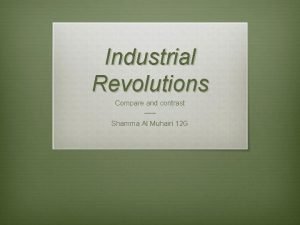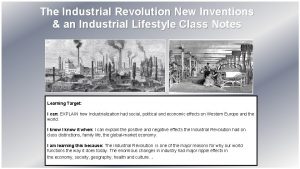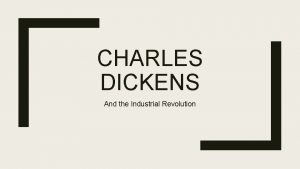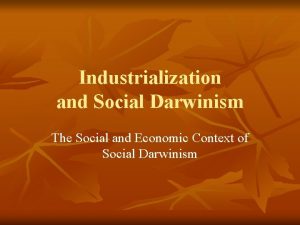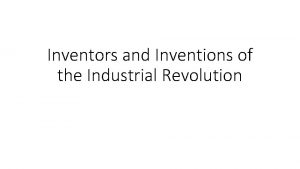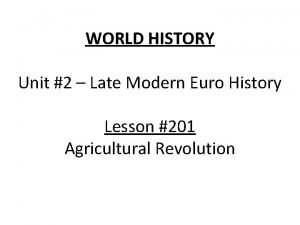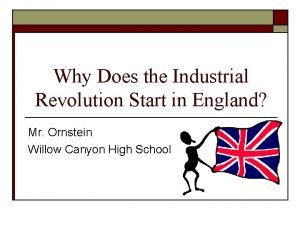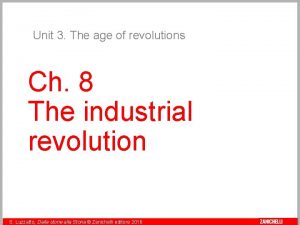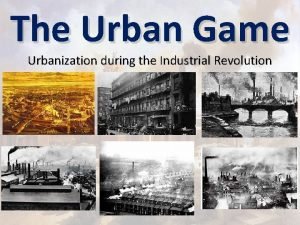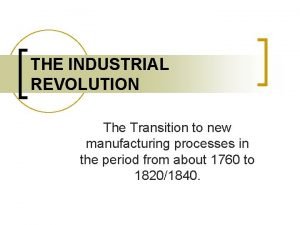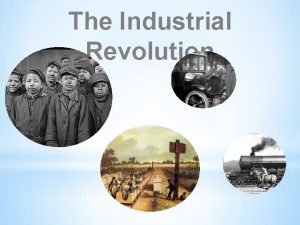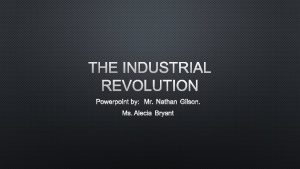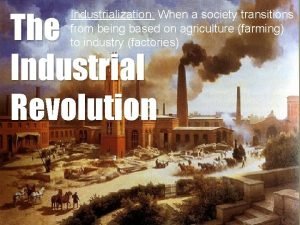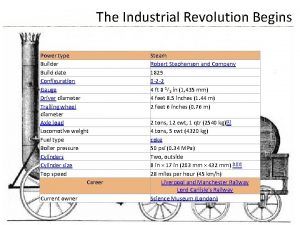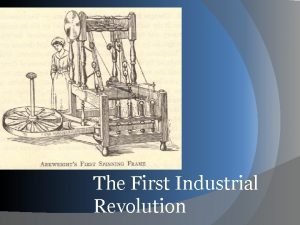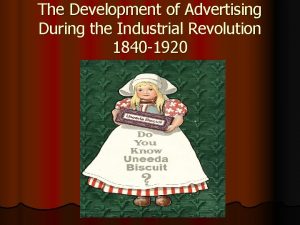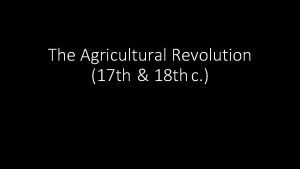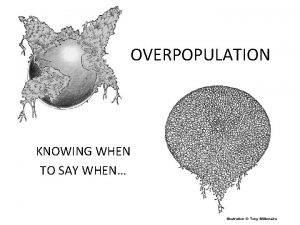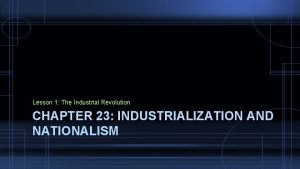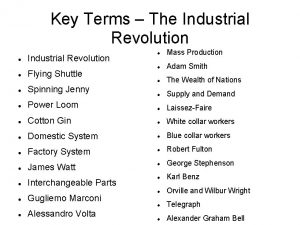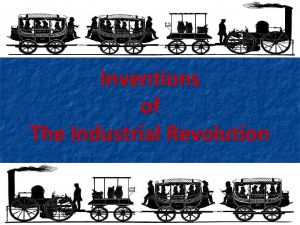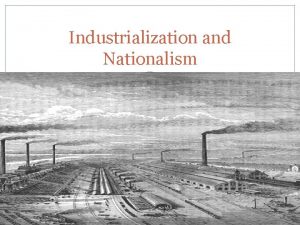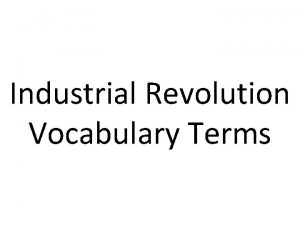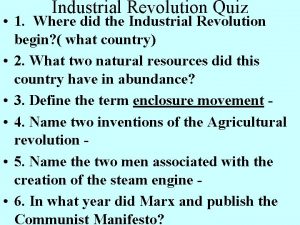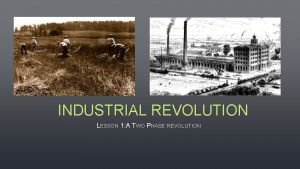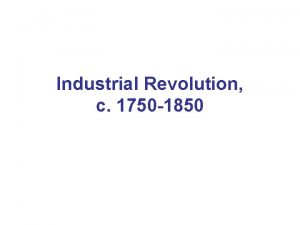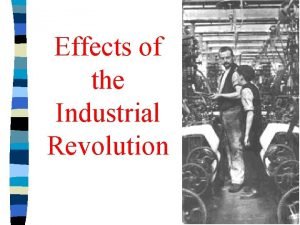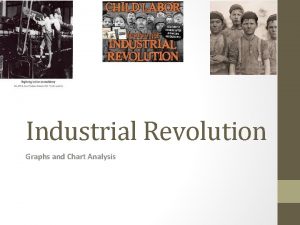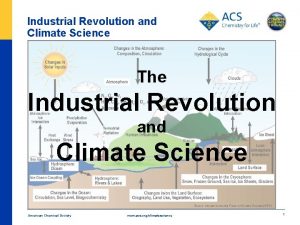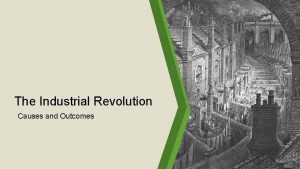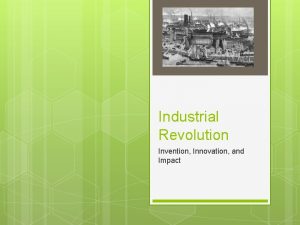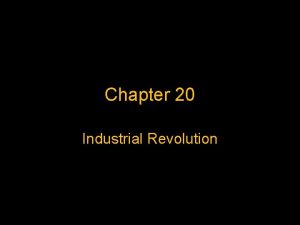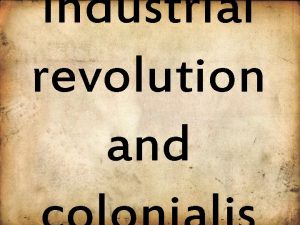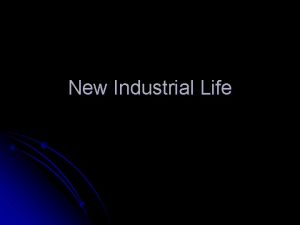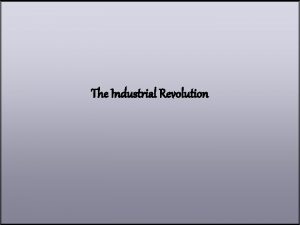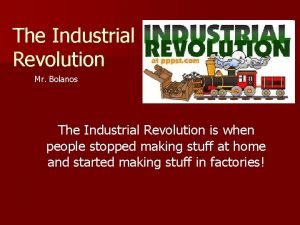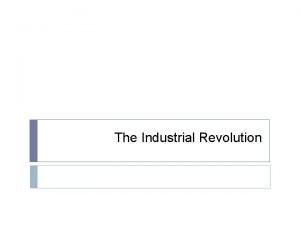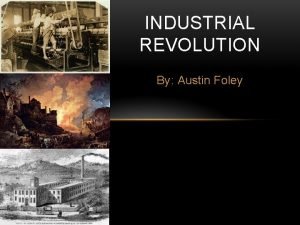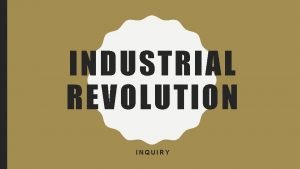The Industrial Revolution Chapters 19 and 21 Aim




































- Slides: 36

The Industrial Revolution Chapters 19 and 21

Aim • Students will be able to identify and describe the causes of the Industrial Revolution.

Questions to answer: 1. Why did the Industrial Revolution begin? 2. Where did the Industrial Revolution begin? 3. What was its overall impact on society?

Life Changes • In 1750 - most people had land worked the land using simple tools • People made their own clothes by hand • People did not travel, or if they did, they did not travel far. • People used horse drawn carriages • In contrast: people in 1850 had land worked in factories, had manufactured clothing, and were able to travel further.

Advancements • Between 1830 -1855 an American dentist was the first to use an anesthetic- drug that prevents pain during surgery. • Skyscrapers

Improvements in farming • Second Agricultural Revolution brought great advancements of farming and farming products. • Educated farmers began to exchange news about experiments they have tried. • New methods of crop rotation • Lord Charles Townshend- urged farmers to grow turnips • Jethro Tull- invented a new seed drill

Enclosure Increases • Enclosure- the process of taking over and consolidating land formerly shared by peasant farmers • By 1700 s- they wanted to create larger fields that could be cultivated more efficiently. • British Parliament facilitated enclosures through legislation • As millions of acres were enclosed, farm output rose and so did profit. • Many farm laborers were thrown out of work • People moved to cities to get jobs working in factories

Population Multiplies • Agricultural revolution contributed to the rapid of the population • Why was there a population increase? • Agricultural revolution reduced the risk of death from famine • Surplus of food • People ate better= people were healthier

New Technology • One vital source of energy was coal- used to develop the steam engine • 1712 - Thomas Newcomen- developed the steam engine • James Watt made Newcomen’s invention more efficient • Production of iron- used to make machines and buildings

Section 2: Britain Leads the Way

Why Britain? • Had the advantage of plentiful natural resources and natural ports • Rivers supplied water power for construction of canals • Canals increased trade • Communication and transportation were prevalent • Had skilled workers who wanted to expand production

Effects of Demand Capital • The British economy was beginning to prosper • Business class had capital- money used to invest in enterprises • Enterprises- business organization in an area such as shipping, mining, railroads, or factories • Britain had a stable government which supported economic growth • Entrepreneurs- those who managed and assummed the financial risks of starting new businesses.

Textile Industry • • The Industrial Revolution first began in the textile industry Took their inspiration from India’s cotton cloth Britain wanted to take India’s cotton cloth industry home Putting-out system- cottage industry- raw cotton was distributed to peasant families who spun it into thread

The Age of Iron and Coal • Iron was needed to create machines and engines • Fuel to create was running out- trees • Turn to coal

Inventions Sped Up Production • Putting-out system took a very long time • In America, inventor Eli Whitney invented a machine called the cotton gin that helped to separate seed from raw cotton to speed up the pace

Factories Are Born • New machines were large and needed room • They were too large and expensive to operate at home • Originally they were in sheds near rivers- they used water power to run • Eventually they required more and more workers and the sheds became larger

Transportation Revolution • As production increased, entrepreneurs needed faster and cheaper methods to move goods from place to place • Used turnpikes- private roads built by entrepreneurs who charged travelers a toll to use them • Goods traveled faster • Canals- water transportation • Locomotives- the use of steam-powered rails. Today we know them as railroads.

Chain reaction • Once inventors developed machines that could produce large qualities of goods more efficiently, prices fell. • Lower prices made goods more affordable and created more consumers who further fed the demands for goods.

Section 3: Social Impact of the Industrial Revolution

Urbanization • Urbanization- movement of people to cities • People would suffer with dangerous conditions like dangerous working and living conditions, unsafe, unsanitary, overcrowded housing, poverty • Population increased in the cities • Where did the cities spring up?

New Social Classes Emerged • The Industrial Revolution created a new middle class along with the working class • Middle class: owned and operated the new factories, mines, railroads, and other industries. Lifestyle was more comfortable than working class. • Working class: packed into tiny rooms, lived in tenements, no running water or sanitation, garbage was on the street





Working Conditions • Men, women, and children worked 12 -16 hours a day • Machines were very dangerous

Women and Children • Women were more desirable than men • Paid less • Adapted more easily • Children: • Originally children were used to work on farms • Had small hands which could be used to do delicate work and to fix machines

Labor Unions • Labor unions- worker organizations • Rallied for better working conditions and better pay

Industrial Revolution and Religion • Methodism • John Wesley- stressed the need for a personal sense of faith • Methodism promised forgiveness of sin and a better life to come • Attempted to rekindle hope among the working poor • Read the Bible

Section 4: New Ways of Thinking • Thomas Malthus: • British economist • Theory: poverty was unavoidable due to the population increase • Looked to natural laws that governed the world of business and economics • Malthus believed the population would outpace the food supply • Urged families to have fewer children • Did not want healthcare for the poor • He was wrong!! The food supply grew faster than the population

Laissez-Faire • Adam Smith- Hands off! • Free Market Economy- the economy would produce more goods at lower prices making them affordable to everyone

David Ricardo • Believed the working class would never escape poverty • Also believed that wage increased were not necessary because they would never help people cover their basic necessities • Did not want the government to help the poor

Utilitarian • Jeremy Bentham believed the goal of society should be the “greatest happiness for the greatest number” • Supported individual freedom • Believed the government should be involved • John Stewart Mill also believed in individual freedom

Utopian • Robert Owen • No difference between rich and poor • Had a “model community” in New Lanark, Scotland where everyone in society worked and shared all property

Communism • System of government led by a small elite where they controlled all economic and political life • Argued that there was “the history of class struggles” between the “haves” and the “have-nots” • Haves- owned and controlled the means of production and ultimately controlled the wealth • Have-nots- proletariat- working class • Workers would take control of the means of production and set up a classless society- end all struggles

Marxism • Never actually practices • Social democracy- a political ideology where there is a gradual transition from capitalism to socialism instead of a sudden violent overthrow of the system • Flawed view of government/economy • By the end of the 20 th century, few nations were communist governments, almost all countries follow freemarket capitalism.
 First and second industrial revolution
First and second industrial revolution Negative effects of the industrial revolution
Negative effects of the industrial revolution Dickens industrial revolution
Dickens industrial revolution Industrial revolution social darwinism
Industrial revolution social darwinism Bessemer process
Bessemer process Russian revolution vs french revolution
Russian revolution vs french revolution Could the french revolution have been avoided
Could the french revolution have been avoided Green revolution vs third agricultural revolution
Green revolution vs third agricultural revolution How changed
How changed Why did the industrial revolution start in britain
Why did the industrial revolution start in britain An age of revolutions zanichelli
An age of revolutions zanichelli The urban game
The urban game Enclosure movement industrial revolution
Enclosure movement industrial revolution Putting-out system
Putting-out system The transition to new manufacturing processes
The transition to new manufacturing processes Industrial revolution quiz
Industrial revolution quiz Industrial revolution powerpoint
Industrial revolution powerpoint The effects of the industrial revolution meme
The effects of the industrial revolution meme Enclosure movement definition industrial revolution
Enclosure movement definition industrial revolution Water frame significance
Water frame significance Industrial revolution advertisement
Industrial revolution advertisement Enclosure movement industrial revolution
Enclosure movement industrial revolution Second industrial revolution timeline
Second industrial revolution timeline Thomas malthus industrial revolution
Thomas malthus industrial revolution Lesson 1 the industrial revolution
Lesson 1 the industrial revolution Flying shuttle industrial revolution
Flying shuttle industrial revolution Who invented the phonograph in the industrial revolution
Who invented the phonograph in the industrial revolution Guided reading activity industrialization and nationalism
Guided reading activity industrialization and nationalism Industrial revolution vocabulary
Industrial revolution vocabulary Entrepreneurs industrial revolution
Entrepreneurs industrial revolution Effects of the industrial revolution
Effects of the industrial revolution Quiz 1: early development of industry
Quiz 1: early development of industry Lesson 1 the industrial revolution
Lesson 1 the industrial revolution Industrial revolution jeopardy
Industrial revolution jeopardy Enclosure movement industrial revolution
Enclosure movement industrial revolution Negative effects of the industrial revolution
Negative effects of the industrial revolution Negative effects of the industrial revolution
Negative effects of the industrial revolution
